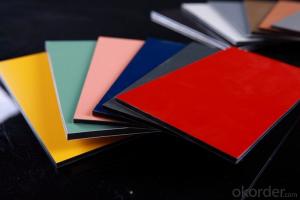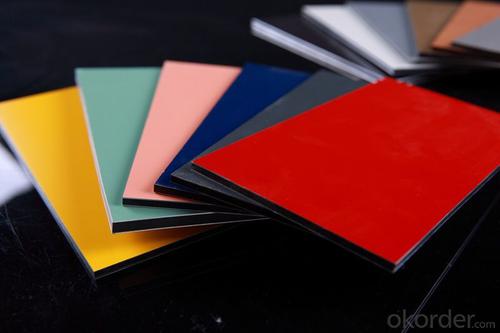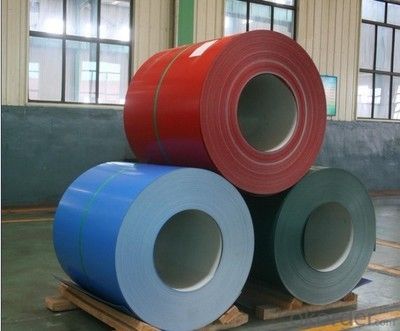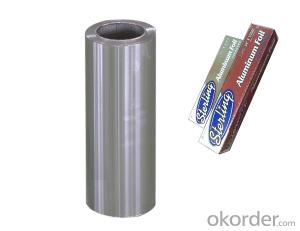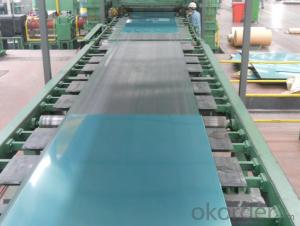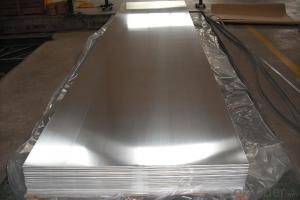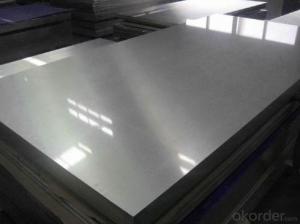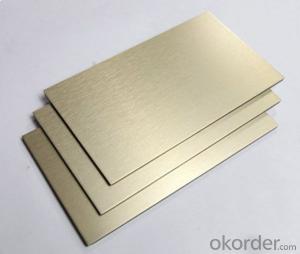Alucobond / Aluminum Composite Panel for Construction - Perforated Aluminum Sheets
- Loading Port:
- Shanghai
- Payment Terms:
- TT OR LC
- Min Order Qty:
- 8 m.t.
- Supply Capability:
- 1000 m.t./month
OKorder Service Pledge
OKorder Financial Service
You Might Also Like
Specification
Structure of Alucobond / Aluminum Composite Panel for Construction Description:
Coated aluminum coil/sheet are of a wide range of colors, which gives wonderful appearance no matter in residential and commercial constructions of great exhibition centers.
The coated aluminum coil/sheet have been widely used in the fields of construction and decoration( garage doors, ceiling etc.), electronic appliances, lighting decoration, air-condition air pipes, sandwich panels and drainages etc.
Main Features of the Alucobond / Aluminum Composite Panel for Construction:
1) High flexibility
2) Impact resistance
3) Excellent weather-proof durability
4) Anti-ultraviolet
5) High erosion resist
Images of the Alucobond / Aluminum Composite Panel for Constructionl:
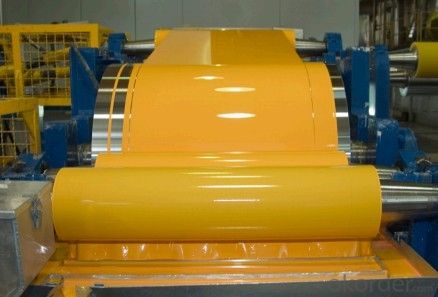
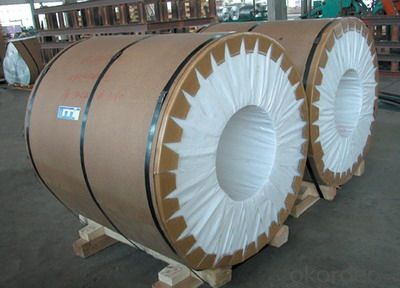
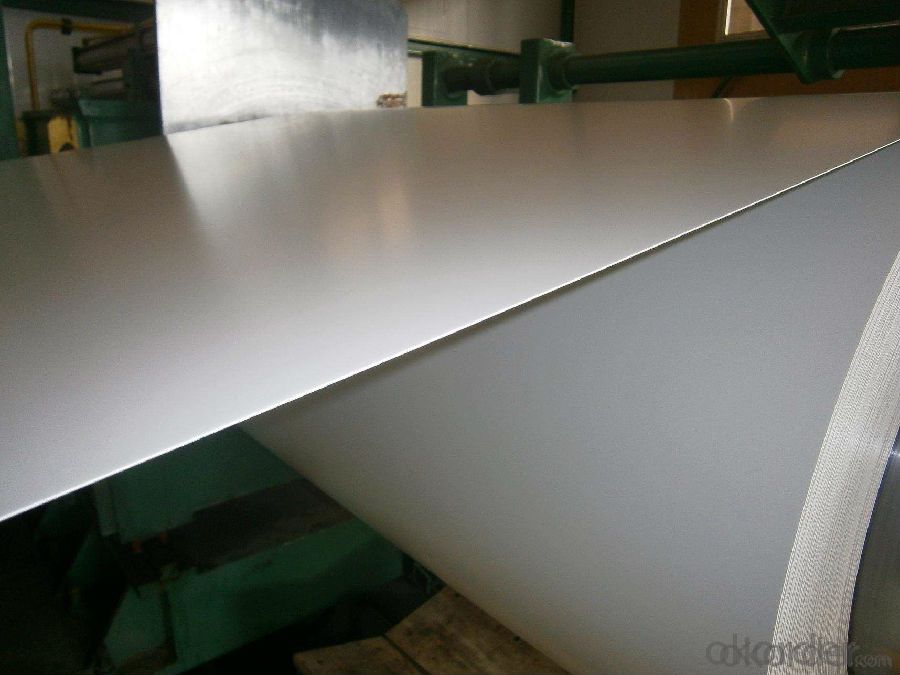
Alucobond / Aluminum Composite Panel for Construction Specification:
Alloy | A1100,A3003,A1050,A8011 etc |
Temper | H16,H18,H24 |
Thickness | From 0.024mm to 1.2mm |
Width | Standard width:1240mm |
Special width:1300mm,1520mm,1570mm,1595mm | |
Diameter | Standard dia:1200mm |
Interior dia:150mm,405mm,505mm | |
Weight | 2.5 T/coil,3.0 T/coil |
Coating | PE, PVDF, AC |
Surface | Embossed, mill finish, coated |
Color | AS to code RAL |
Gloss | 10-90%(EN ISO-2813:1994) |
Coating Thickness | PE: more than 18 micron |
PVDF: more than 25 micron | |
Coating Hardness (pencil resistance) | More than 2h |
Coating adhesion | 5J(EN ISO-2409:1994) |
Impact Resistance | No peeling or cracking(50 kg/cm,ASTMD-2794:1993) |
Flexibility (T-bend) | 2T |
MEK resistance | More than 100 |
FAQ:
a.What is monthly capacity
---CNBM is one stated own company and our monthly capacity is about 2000tons.
b. Now which countries do you export your goods?
---Now we export to South East Asia,Africa, North America,South America ect.
- Q: Are aluminum sheets suitable for wastewater treatment applications?
- Indeed, aluminum sheets prove to be suitable for wastewater treatment applications. With its versatility, aluminum presents several advantages when utilized in wastewater treatment processes. Firstly, aluminum sheets exhibit a high resistance to corrosion, a crucial feature given the harsh and corrosive environment of wastewater treatment plants. This resistance ensures that the aluminum sheets remain intact and unaffected by the chemicals present in the wastewater, thereby preserving their structural integrity. Moreover, aluminum sheets possess exceptional thermal conductivity properties, enabling efficient heat transfer in processes such as wastewater disinfection. This thermal conductivity facilitates the effective elimination of harmful bacteria and contaminants from the wastewater, thereby enhancing the overall treatment process. Furthermore, aluminum sheets are not only lightweight but also durable, making them easy to handle and install in wastewater treatment systems. This characteristic also contributes to their cost-effectiveness, as they require less maintenance and are less susceptible to damage compared to alternative materials. Additionally, aluminum is a sustainable material that can be recycled, thus reducing the environmental impact of wastewater treatment applications. Recycling aluminum sheets aids in the conservation of natural resources and minimizes energy consumption, making it an environmentally friendly choice. In conclusion, aluminum sheets offer a multitude of advantages for wastewater treatment applications. Their corrosion resistance, thermal conductivity, lightweight nature, and recyclability render them a suitable and efficient material for use in wastewater treatment processes.
- Q: Are the aluminum sheets suitable for manufacturing electronic enclosures?
- Yes, aluminum sheets are suitable for manufacturing electronic enclosures. Aluminum is lightweight yet sturdy, providing excellent protection for electronic components. It is also corrosion-resistant, making it suitable for various environments. Additionally, aluminum is a good conductor of heat, allowing for effective thermal management in electronic enclosures.
- Q: ... initial temperature of the water or the initial temperature of the aluminum? Why?
- The correct equation is: dQ = m*c*dT As dQ (substitute of thermal potential) and mass are the comparable, the equation may well be rewritten as: c*dT=consistent So a cloth with a decrease specific warmth skill could have a much better improve in temperature. The question has already suggested this yet now all of us be attentive to they are inversely proportional. to that end: c of aluminium/c of copper = dT of aluminium / dT of copper 0.22/0.092 = proportionality consistent = 2.39 So copper would be 2.4 circumstances warmer than aluminium (or aluminium would be 0.40 two circumstances warmer than copper).
- Q: Can aluminum sheets be an alternative to glass in certain applications?
- Certain applications can consider aluminum sheets as an alternative to glass. Aluminum sheets provide various benefits over glass, making them suitable for specific scenarios. To begin with, aluminum sheets possess lightweight and durable characteristics, making them an excellent choice for industries like aerospace or automotive, where weight is a concern. Conversely, glass is relatively heavy and brittle, limiting its usage in certain environments. Moreover, aluminum sheets exhibit exceptional resistance to corrosion, making them a suitable option for marine or coastal applications, where glass may deteriorate over time due to exposure to saltwater. Aluminum sheets also possess a high strength-to-weight ratio, enabling greater design flexibility and structural integrity compared to glass. Furthermore, aluminum sheets offer superior thermal insulation properties in comparison to glass. They provide improved resistance to heat transfer, which is advantageous in applications where temperature control is crucial, like the construction industry. Additionally, aluminum sheets can be more cost-effective than glass in specific applications. The production and installation costs of aluminum sheets are often lower than glass, making them a more economical choice for large-scale projects. However, it is important to acknowledge that glass retains its own unique properties and advantages, such as transparency and optical clarity. Glass also has better resistance to scratches and chemical corrosion when compared to aluminum sheets. In conclusion, while aluminum sheets can serve as a viable alternative to glass in certain applications due to their lightweight, durability, corrosion resistance, thermal insulation properties, and cost-effectiveness, the final decision between the two materials depends on the specific requirements and limitations of the application at hand.
- Q: This question asks about the distinctions between aluminum sheets that are produced domestically versus those that are imported.
- <p>Yes, there can be differences between domestic and imported aluminum sheets. These differences may include quality standards, material composition, thickness, surface finish, and price. Domestic sheets are often produced to meet local standards and regulations, while imported sheets may adhere to different international standards. The manufacturing process and raw materials used can also vary, leading to differences in durability, strength, and workability. Additionally, imported sheets might have different certifications or come from countries with lower production costs, which can affect the price. However, it's important to note that not all imported aluminum sheets are of lower quality; some may be of higher quality or have specific characteristics that are not available domestically.</p>
- Q: What are the different methods of surface preparation for aluminum sheet?
- Depending on the desired finish and purpose, there are various approaches to preparing aluminum sheet surfaces. 1. Chemical Cleaning: To eliminate dirt, grease, and contaminants, chemical solutions are employed. The sheet is typically soaked in the cleaning solution and thoroughly rinsed to ensure complete removal of any residues. 2. Mechanical Cleaning: Imperfections or coatings are removed through mechanical processes like sanding, grinding, or brushing. Abrasive materials or tools are used for sanding or grinding, while wire brushes are employed for brushing. 3. Etching: A textured finish that enhances adhesion for subsequent coatings or finishes is achieved through the application of acid or alkaline solutions to the aluminum sheet. This process removes a thin layer of the metal, creating a rough surface. 4. Anodizing: By immersing the sheet in an electrolytic solution and passing an electric current through it, an oxide layer is formed on the aluminum sheet. Anodizing not only improves the appearance but also provides protection against corrosion. 5. Conversion Coating: The surface of the aluminum sheet is converted into a more corrosion-resistant material through chemical processes like chromate or phosphate conversion coating. These coatings offer additional protection and improve the bonding of subsequent coatings. Each method of surface preparation for aluminum sheet has distinct advantages and is selected based on specific requirements. It is crucial to choose the appropriate method to ensure proper adhesion of coatings and finishes, as well as to enhance the overall durability and appearance of the aluminum sheet.
- Q: how would you use aluminum to extract silver from film?just ideas please
- The silver in film is part of a silver salt (silver halides.) It is a very very small amount, probably less than 1 cent worth per roll. You would be a lot better off selling the film than trying to extract the silver from it. If you are hell bent on it, the first step is to expose the film to light. This will break the silver from the halides. Then you can go about trying to figure out how to get the silver apart from the film. I am sure it is possible, but it would involve a lot of work. I imagine you you would spend about $100 on ever $1 worth of silver you could extract.
- Q: I have a problem when machining aluminium in my machine shop. There are times when the machines aluminium surface turns yellowish (somtimes brown). I do not know what is the main cause of the problem. Is it due to the coolant used?
- Aluminum oxides may appear in different colors depending on hydration states and other variables. Look in a CRC Handbook of Chemistry Physics if available for aluminum compounds and their colors. The colors that you see may also have as much to do with the surface finish as the color of the material on the surface. A microscopically rough surface will appear dark next to a polished surface due to light scattering. I will agree with Ling in principle, but not on details. EDS detection limits on homogeneous samples can be better than 0.1%, although not so good for elements at the light end of the detection range. Current detectors can detect chlorine (a common culprit for aluminum discoloration) at about 0.1%. Your problem with detection and one that Ling has addressed previously may be that a thin film of contamination would not be easily detected by EDS. As Ling suggests, SIMS is a good technique for detecting thin films and low concentrations. The problem with SIMS in this case may be that the detection limits are too good and the technique cannot be quantified. SIMS would detect 2 ppm of chloride and you couldn't tell for sure whether it was 2 ppm, which is probably not an issue here, or 2000 ppm, which would be significant. I would suggest x-ray photoelectron spectroscopy (ESCA or XPS) as an alternative for further study. The technique will analyze thin films (20 A) and detection limits are good enough (about 0.1%). In addition, XPS will give you information about the compounds present, e.g. whether the oxygen is aluminum oxide, aluminum hydroxide, etc. Good Luck.
- Q: How do I join aluminum sheets together?
- To join aluminum sheets together, various methods can be utilized depending on the specific application and desired outcome. Here are several commonly employed techniques: 1. Riveting: Aluminum sheets can be joined by using rivets, which are small metal fasteners. This involves drilling holes in the sheets and then inserting the rivets, which are permanently secured by deforming or compressing them. Riveting is a widely used and durable method for joining aluminum sheets. 2. Welding: Aluminum welding can be accomplished through methods such as gas tungsten arc welding (GTAW), gas metal arc welding (GMAW), or laser welding. These techniques involve melting the aluminum at the joint, allowing it to fuse and create a strong bond upon cooling. Welding necessitates specialized equipment and expertise, but it provides a robust and permanent joining solution. 3. Adhesive bonding: This method employs industrial-grade adhesives specifically designed for bonding aluminum. The adhesive is applied to the surfaces to be joined, and then the sheets are pressed together and allowed to cure. Adhesive bonding results in a clean and aesthetically pleasing joint, although it may not be suitable for high-stress applications. 4. Mechanical fasteners: Another option for joining aluminum sheets is the use of screws, bolts, or nuts. This method entails drilling holes in the sheets and employing fasteners to secure them together. Mechanical fasteners offer a strong and adjustable joint, making disassembly easier if required. Before selecting a joining method, it is important to consider factors such as the strength requirements, appearance, ease of assembly, and disassembly of the application. Additionally, adhering to safety guidelines and seeking professional advice is essential if uncertainty or lack of experience with joining aluminum sheets exists.
- Q: How do I calculate the weight of aluminum sheet? What is the density?
- The density of aluminum is 2.7g/cm^3.
Send your message to us
Alucobond / Aluminum Composite Panel for Construction - Perforated Aluminum Sheets
- Loading Port:
- Shanghai
- Payment Terms:
- TT OR LC
- Min Order Qty:
- 8 m.t.
- Supply Capability:
- 1000 m.t./month
OKorder Service Pledge
OKorder Financial Service
Similar products
Hot products
Hot Searches
Related keywords
